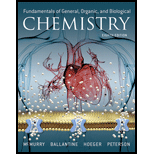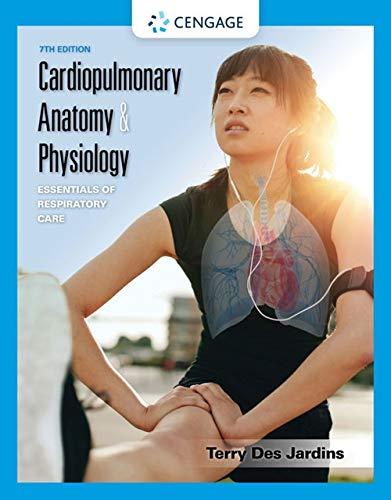
Fundamentals of General, Organic, and Biological Chemistry (8th Edition)
8th Edition
ISBN: 9780134015187
Author: John E. McMurry, David S. Ballantine, Carl A. Hoeger, Virginia E. Peterson
Publisher: PEARSON
expand_more
expand_more
format_list_bulleted
Concept explainers
Question
Chapter 8.5, Problem 8.9P
Interpretation Introduction
Interpretation:
The volume of oxygen which has an initial volume of
Concept Introduction:
Boyle’s law:
At fixed temperature, the volume of a fixed amount of gas is inversely proportional to the pressure exerted by the gas.
Expert Solution & Answer
Want to see the full answer?
Check out a sample textbook solution
Students have asked these similar questions
please draw it for me and tell me where i need to modify the structure
Please help determine the standard curve for my Kinase Activity in Excel Spreadsheet.
Link: https://mnscu-my.sharepoint.com/personal/vi2163ss_go_minnstate_edu/_layouts/15/Doc.aspx?sourcedoc=%7B958f5aee-aabd-45d7-9f7e-380002892ee0%7D&action=default&slrid=9b178ea1-b025-8000-6e3f-1cbfb0aaef90&originalPath=aHR0cHM6Ly9tbnNjdS1teS5zaGFyZXBvaW50LmNvbS86eDovZy9wZXJzb25hbC92aTIxNjNzc19nb19taW5uc3RhdGVfZWR1L0VlNWFqNVc5cXRkRm4zNDRBQUtKTHVBQldtcEtWSUdNVmtJMkoxQzl3dmtPVlE_cnRpbWU9eEE2X291ZHIzVWc&CID=e2126631-9922-4cc5-b5d3-54c7007a756f&_SRM=0:G:93
Determine the amount of VRK1 is present
1. Average the data and calculate the mean absorbance for each concentration/dilution (Please over look for Corrections)
2. Blank Correction à Subtract 0 ug/mL blank absorbance from all readings (Please over look for Corrections)
3. Plot the Standard Curve (Please over look for Corrections)
4. Convert VRK1 concentration from ug/mL to g/L
5. Use the molar mass of VRK1 to convert to M and uM…
Macmillan Learning
Cholesterol synthesis begins with the formation of mevalonate from acetyl CoA. This
process activates mevalonate and converts it to isopentenyl pyrophosphate.
Identify the atoms in mevalonate and isopentenyl pyrophosphate that will be labeled
from acetyl CoA labeled with 14C in the carbonyl carbon. Place 14C atoms and C atoms
to denote which carbon atoms are labeled and which are not labeled.
H₂C
COA
14C-labeled acetyl-CoA
HHH
[c]
H
H
OH
014C
- OH
H
HH
H
Mevalonate
CH3
H H
14C
H
Η
H
H
Incorrect Answer
of o
-P-O-P-0-
Isopentenyl pyrophosphate
с
Answer Bank
14C
Chapter 8 Solutions
Fundamentals of General, Organic, and Biological Chemistry (8th Edition)
Ch. 8.2 - Would you expect the boiling points to increase or...Ch. 8.2 - Prob. 8.3PCh. 8.2 - Identify the intermolecular forces (dipoledipole,...Ch. 8.4 - Prob. 8.5PCh. 8.4 - Prob. 8.6PCh. 8.4 - What evidence is there that global warming is...Ch. 8.4 - Prob. 8.2CIAPCh. 8.4 - Prob. 8.7PCh. 8.4 - Prob. 8.8KCPCh. 8.5 - Prob. 8.3CIAP
Ch. 8.5 - Prob. 8.4CIAPCh. 8.5 - Prob. 8.5CIAPCh. 8.5 - Prob. 8.9PCh. 8.5 - Prob. 8.10PCh. 8.6 - Prob. 8.11PCh. 8.7 - Prob. 8.12PCh. 8.8 - Prob. 8.13PCh. 8.8 - Prob. 8.14KCPCh. 8.9 - Prob. 8.15PCh. 8.10 - Prob. 8.16PCh. 8.10 - Prob. 8.17PCh. 8.10 - Prob. 8.18KCPCh. 8.11 - Prob. 8.19PCh. 8.11 - Prob. 8.20PCh. 8.11 - Prob. 8.21PCh. 8.11 - Prob. 8.22KCPCh. 8.14 - How much heat in kilocalories is required to (a)...Ch. 8.14 - Prob. 8.24PCh. 8.14 - Compare the Hvap values for water, isopropyl...Ch. 8.14 - What is a supercritical fluid?Ch. 8.14 - What are the environmental advantages of using...Ch. 8.14 - Prob. 8.8CIAPCh. 8 - Prob. 8.26UKCCh. 8 - Assume that you have a sample of gas at 350 K in a...Ch. 8 - Prob. 8.28UKCCh. 8 - Three bulbs, two of which contain different gases...Ch. 8 - Prob. 8.30UKCCh. 8 - The following graph represents the heating curve...Ch. 8 - Prob. 8.32UKCCh. 8 - Prob. 8.33UKCCh. 8 - Prob. 8.34APCh. 8 - Identify the predominant intermolecular force in...Ch. 8 - Dimethyl ether (CH3OCH3) and ethanol (C2H5OH) have...Ch. 8 - Prob. 8.37APCh. 8 - Prob. 8.38APCh. 8 - Prob. 8.39APCh. 8 - What are the four assumptions of the...Ch. 8 - Prob. 8.41APCh. 8 - Prob. 8.42APCh. 8 - Prob. 8.43APCh. 8 - Prob. 8.44APCh. 8 - Prob. 8.45APCh. 8 - Prob. 8.46APCh. 8 - Which assumptions of the kinetic-molecular theory...Ch. 8 - Prob. 8.48APCh. 8 - Prob. 8.49APCh. 8 - The use of CFCs as refrigerants and propellants in...Ch. 8 - Prob. 8.51APCh. 8 - Prob. 8.52APCh. 8 - Prob. 8.53APCh. 8 - Prob. 8.54APCh. 8 - Prob. 8.55APCh. 8 - Prob. 8.56APCh. 8 - Prob. 8.57APCh. 8 - Prob. 8.58APCh. 8 - Which assumptions of the kinetic-molecular theory...Ch. 8 - Prob. 8.60APCh. 8 - Prob. 8.61APCh. 8 - Prob. 8.62APCh. 8 - Prob. 8.63APCh. 8 - Prob. 8.64APCh. 8 - Prob. 8.65APCh. 8 - Prob. 8.66APCh. 8 - Prob. 8.67APCh. 8 - Prob. 8.68APCh. 8 - Prob. 8.69APCh. 8 - Prob. 8.70APCh. 8 - Prob. 8.71APCh. 8 - What is the mass of CH4 in a sample that occupies...Ch. 8 - Prob. 8.73APCh. 8 - Prob. 8.74APCh. 8 - Prob. 8.75APCh. 8 - Prob. 8.76APCh. 8 - Prob. 8.77APCh. 8 - Prob. 8.78APCh. 8 - Prob. 8.79APCh. 8 - Prob. 8.80APCh. 8 - Prob. 8.81APCh. 8 - Prob. 8.82APCh. 8 - Prob. 8.83APCh. 8 - Prob. 8.84APCh. 8 - Prob. 8.85APCh. 8 - Prob. 8.86APCh. 8 - Prob. 8.87APCh. 8 - Prob. 8.88APCh. 8 - Prob. 8.89APCh. 8 - Prob. 8.90APCh. 8 - Prob. 8.91APCh. 8 - Prob. 8.92APCh. 8 - Prob. 8.93APCh. 8 - Prob. 8.94APCh. 8 - Patients with a high body temperature are often...Ch. 8 - Prob. 8.96APCh. 8 - List three kinds of crystalline solids, and give...Ch. 8 - The heat of fusion of acetic acid, the principal...Ch. 8 - Prob. 8.99APCh. 8 - Prob. 8.100CPCh. 8 - Prob. 8.101CPCh. 8 - Prob. 8.102CPCh. 8 - Prob. 8.103CPCh. 8 - Prob. 8.104CPCh. 8 - Prob. 8.105CPCh. 8 - Prob. 8.106CPCh. 8 - Prob. 8.107CPCh. 8 - Prob. 8.108CPCh. 8 - Ethylene glycol, C2H6O2, has one OH bonded to each...Ch. 8 - Prob. 8.110CPCh. 8 - Prob. 8.111GPCh. 8 - Prob. 8.112GPCh. 8 - Prob. 8.113GPCh. 8 - Prob. 8.114GPCh. 8 - Prob. 8.115GP
Knowledge Booster
Learn more about
Need a deep-dive on the concept behind this application? Look no further. Learn more about this topic, biochemistry and related others by exploring similar questions and additional content below.Similar questions
- Draw the reaction between sphingosine and arachidonic acid. Draw out the full structures.arrow_forwardDraw both cis and trans oleic acid. Explain why cis-oleic acid has a melting point of 13.4°C and trans-oleic acid has a melting point of 44.5°C.arrow_forwardDraw the full structure of the mixed triacylglycerol formed by the reaction of glycerol and the fatty acids arachidic, lauric and trans-palmitoleic. Draw the line structure.arrow_forward
- Draw out the structure for lycopene and label each isoprene unit. "Where is lycopene found in nature and what health benefits does it provide?arrow_forwardWhat does it mean to be an essential fatty acid? What are the essential fatty acids?arrow_forwardCompare and contrast primary and secondary active transport mechanisms in terms of energy utilisation and efficiency. Provide examples of each and discuss their physiological significance in maintaining ionic balance and nutrient uptake. Rubric Understanding the key concepts (clearly and accurately explains primary and secondary active transport mechanisms, showing a deep understanding of their roles) Energy utilisation analysis ( thoroughly compares energy utilisation in primary and secondary transport with specific and relevant examples Efficiency discussion Use of examples (provides relevant and accurate examples (e.g sodium potassium pump, SGLT1) with clear links to physiological significance. Clarity and structure (presents ideas logically and cohesively with clear organisation and smooth transition between sections)arrow_forward
- 9. Which one of the compounds below is the major organic product obtained from the following reaction sequence, starting with ethyl acetoacetate? 요요. 1. NaOCH2CH3 CH3CH2OH 1. NaOH, H₂O 2. H3O+ 3. A OCH2CH3 2. ethyl acetoacetate ii A 3. H3O+ OH B C D Earrow_forward7. Only one of the following ketones cannot be made via an acetoacetic ester synthesis. Which one is it? Ph کہ A B C D Earrow_forward2. Which one is the major organic product obtained from the following reaction sequence? HO A OH 1. NaOEt, EtOH 1. LiAlH4 EtO OEt 2. H3O+ 2. H3O+ OH B OH OH C -OH HO -OH OH D E .CO₂Etarrow_forward
- what is a protein that contains a b-sheet and how does the secondary structure contributes to the overall function of the protein.arrow_forwarddraw and annotate a b-sheet and lable the hydrogen bonding. what is an example that contains the b-sheet and how the secondary structure contributes to the overall function of your example protein.arrow_forwardFour distinct classes of interactions (inter and intramolecular forces) contribute to a protein's tertiary and quaternary structures. Name the interaction then describe the amino acids that can form this type of interaction. Draw and annotate a diagram of the interaction between two amino acids.arrow_forward
arrow_back_ios
SEE MORE QUESTIONS
arrow_forward_ios
Recommended textbooks for you
 Human Physiology: From Cells to Systems (MindTap ...BiologyISBN:9781285866932Author:Lauralee SherwoodPublisher:Cengage Learning
Human Physiology: From Cells to Systems (MindTap ...BiologyISBN:9781285866932Author:Lauralee SherwoodPublisher:Cengage Learning Cardiopulmonary Anatomy & PhysiologyBiologyISBN:9781337794909Author:Des Jardins, Terry.Publisher:Cengage Learning,
Cardiopulmonary Anatomy & PhysiologyBiologyISBN:9781337794909Author:Des Jardins, Terry.Publisher:Cengage Learning,- Basic Clinical Lab Competencies for Respiratory C...NursingISBN:9781285244662Author:WhitePublisher:Cengage


Human Physiology: From Cells to Systems (MindTap ...
Biology
ISBN:9781285866932
Author:Lauralee Sherwood
Publisher:Cengage Learning

Cardiopulmonary Anatomy & Physiology
Biology
ISBN:9781337794909
Author:Des Jardins, Terry.
Publisher:Cengage Learning,

Basic Clinical Lab Competencies for Respiratory C...
Nursing
ISBN:9781285244662
Author:White
Publisher:Cengage

